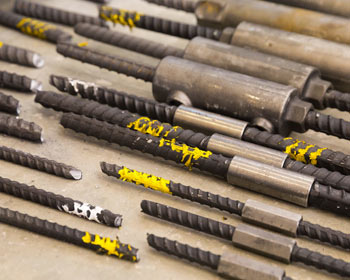

Research Reports |
| Title: | Mechanical Bar Splices for Accelerated Construction of Bridge Columns |
| Authors: | Puskar Dahal, Mostafa Tazarv, and Nadim Wehbe |
| University: | South Dakota State University |
| Publication Date: | Feb 2019 |
| Report #: | MPC-19-372 |
| Project #: | MPC-511 |
| TRID #: | 01698928 |
| Keywords: | bridge construction, columns, deformation curve, dislocation (geology), ductility, earthquake resistant design, failure, load tests, reinforced concrete bridges, reinforcing bars, splicing, test procedures |
| Type: | Research Report – MPC Publications |
 Compared with conventional lap splicing, mechanical splicing is an alternative method of connecting bars in reinforced concrete (RC) structures, and is used mainly to reduce bar congestion in joints. Recently, mechanical bar splices, which are also referred to as bar couplers, have been used in laboratories as a new type of precast column connection to accelerate bridge construction. Nevertheless, current codes prohibit the use of bar couplers in the plastic hinge regions of bridge columns in high seismic zones. This may be due to a lack of systematic test data on the coupler performance, limited experimental studies on mechanically spliced bridge columns, and engineering precautions. The present experimental and analytical studies were performed to (1) generate the first-of-its-kind experimental database of the bar coupler performance, (2) quantify the coupler stress-strain relationship, and (3) quantify the seismic performance of mechanically spliced bridge columns. All U.S. manufacturers of mechanical bar splices were contacted to collect couplers that could potentially be incorporated into bridge columns. Ten different coupler products were selected, and more than 160 mechanical bar splices were tested under uniaxial monotonic and cyclic loading to failure. Properties of the couplers were established, and a coupler material model adopted from the literature was verified. Furthermore, a parametric study was carried out to investigate the seismic performance of mechanically spliced bridge columns utilizing the verified coupler models. More than 240 pushover analyses were performed. It was found that bridge columns incorporating couplers may exhibit 43% lower displacement ductility capacity compared with conventional RC columns, and the force capacity of these columns is slightly higher than that of the RC columns. Columns spliced with rigid and long couplers will show the lowest displacement capacities. Finally, new standard testing methods for mechanical bar splices were proposed based on the findings of the present study, and it was shown that consistent and reliable results could be achieved using the proposed testing methods.
Compared with conventional lap splicing, mechanical splicing is an alternative method of connecting bars in reinforced concrete (RC) structures, and is used mainly to reduce bar congestion in joints. Recently, mechanical bar splices, which are also referred to as bar couplers, have been used in laboratories as a new type of precast column connection to accelerate bridge construction. Nevertheless, current codes prohibit the use of bar couplers in the plastic hinge regions of bridge columns in high seismic zones. This may be due to a lack of systematic test data on the coupler performance, limited experimental studies on mechanically spliced bridge columns, and engineering precautions. The present experimental and analytical studies were performed to (1) generate the first-of-its-kind experimental database of the bar coupler performance, (2) quantify the coupler stress-strain relationship, and (3) quantify the seismic performance of mechanically spliced bridge columns. All U.S. manufacturers of mechanical bar splices were contacted to collect couplers that could potentially be incorporated into bridge columns. Ten different coupler products were selected, and more than 160 mechanical bar splices were tested under uniaxial monotonic and cyclic loading to failure. Properties of the couplers were established, and a coupler material model adopted from the literature was verified. Furthermore, a parametric study was carried out to investigate the seismic performance of mechanically spliced bridge columns utilizing the verified coupler models. More than 240 pushover analyses were performed. It was found that bridge columns incorporating couplers may exhibit 43% lower displacement ductility capacity compared with conventional RC columns, and the force capacity of these columns is slightly higher than that of the RC columns. Columns spliced with rigid and long couplers will show the lowest displacement capacities. Finally, new standard testing methods for mechanical bar splices were proposed based on the findings of the present study, and it was shown that consistent and reliable results could be achieved using the proposed testing methods.
Dahal, Puskar, Mostafa Tazarv, and Nadim Wehbe. Mechanical Bar Splices for Accelerated Construction of Bridge Columns, MPC-19-372. North Dakota State University - Upper Great Plains Transportation Institute, Fargo: Mountain-Plains Consortium, 2019.